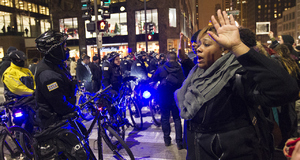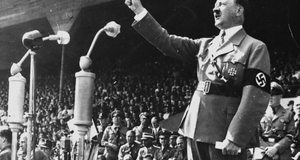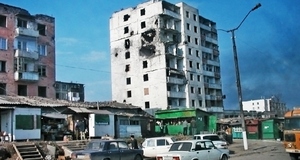From Elon Journal of Undergraduate Research in Communications VOL. 6 NO. 2Human Rights Framing in U.S. Newspaper Coverage of the Sochi Olympic Preparations
IN THIS ARTICLE
KEYWORDS
AbstractEvery two years, the global spotlight shines on the Olympics and the nation hosting the worldwide event, particularly the country's record on human rights. This project looked at how two American newspapers, The New York Times and The Washington Post, examined human rights in Russia in their coverage of the Sochi Games before their start in order to determine and analyze the framing of this mega-event to a U.S. audience. This paper analyzed content in 170 articles published in the two years leading up to the 2014 Sochi Winter Olympic Games. I. IntroductionEvery two years, the global spotlight shines on the Olympics and the nation hosting them. The Games provide an example of a "mega-event," which means a globally recognized occurrence of "shortlived collective cultural actions" that are perceived to have "extra-ordinary status" based on their large scale and scope (Xi, 2013). These mega-events attract media engagement from around the globe, and their host nations have long used such events as opportunities to reframe their national narratives and achieve greater status in the international community (Roche, 2000; Black, 2006). In addition to international recognition, mega-events give nations the chance to appease and unify their domestic population and "instill pride and loyalty" (Xi, 2013). Nations compete for the daunting task of hosting the Olympics in the hopes of reaping these benefits, but host nations also face great risk. Winning the right to host does not guarantee achieving these goals. If a host nation does not meet international expectations, the result can dramatically set the nation back in its quest for international prestige and domestic unity: "A failed event with all the world watching can render a government politically vulnerable at home and abroad" (Giffard & Rivenburgh, 2000, p. 10). This paper seeks to explore this tension between the potential gains and the possibility of a globally visible failure, one of the most pressing issues modern Olympic hosts face, through the case of the most recent Olympic host, Sochi, Russia. The Olympic Games are inextricably linked to human rights. According to the charter of the International Olympic Committee, "The practice of sport is a human right. Every individual must have the possibility of practicing sport, without discrimination of any kind and in the Olympic spirit, which requires mutual understanding with a spirit of friendship, solidarity and fair play" (International Olympic Committee, 2014). Therefore, by hosting the Games, a host country invites examination and often criticism of its human rights record. This project looks at how American newspapers examined human rights in their coverage of the Sochi Games before their start in order to determine and analyze the framing of this mega-event to a U.S. audience. II. Literature ReviewThis paper reviewed literature on framing theory and how newspaper coverage has been affected by their own countries' relations with the Olympic host countries in general and in association with human rights issues. Framing TheorySince McCombs and Shaw (1972) developed the agenda-setting theory, scholars have been examining the salience of media coverage. They defined agenda setting as the selection of particular information to convey a story over other information, which they suggested could shape the public's perception of what is important. Entman (1993) later expanded upon this theory, widening the view to the concept of media framing, which addresses journalist actions of selecting certain parts of a perceived reality to communicate and "promote a particular problem definition, causal interpretation, moral evaluation, and/ or treatment recommendation" (p.52). Scheufele (1999) took the idea even further by developing a process model of framing that demonstrates the interdependent relationships between the frames set by the media and the frames demanded by the audience. The concepts of framing and agenda setting form the basis of journalism research as studies like these reveal the ways in which media producers intentionally or unintentionally convey messages to their audiences, which in turn influences the events and information that audiences perceive as newsworthy or pertinent to their lives. Framing and Public OpinionUsing framing theory to analyze international news coverage, researchers revealed a correlation between negative media coverage and negative public opinion of each nation. Besova and Cooley (2009), for example, examined United States and United Kingdom print coverage of nine nations and revealed a correlation between the tone of the news coverage, whether it depicted a foreign nation in a positive or negative light, and the public's opinion of the nation. Wanta, Golan, and Lee (2004) arrived at a similar conclusion through an analysis of U.S. broadcast coverage, although the authors found a correlation only between negative coverage and negative public opinion. Narratives of Mega-EventsAs mentioned before, mega-events attract international coverage and, therefore, magnify a host nation in the international community. Black (2006) analyzed the narratives these host nations constructed and packaged to spread to the global community. For example, he found that, in hosting the World Cup in 2010, South Africa sought to combat its previous global narrative, which defined the country as a developing nation on the world's poorest continent still struggling to overcome the effects of apartheid. Xi (2013) similarly focused on the symbolic significance of mega-events for host nations, but limited the study only to how this symbolism affected the nation's image domestically. The study analyzed China Central Television's broadcast of the opening ceremony of the Beijing Olympics focusing on both the performance and how it was framed through the details that the cameras chose to highlight. Through this analysis, the study determined the modes with which this "media ritual" communicated a narrative of pride in a national Chinese identity to its people. Recognizing the symbolic importance these events hold to their hosts, Adranovich, Burbank, and Heying (2001) have defined the idea of "the mega-event strategy," which host nations and cities adopt in order to stimulate and justify development. Analyzing the Olympic bids of Los Angeles, Atlanta, and Salt Lake City, the research found that all three cities used rhetoric focused on economic growth and image enhancement on the global stage to promote themselves to the IOC. The study also acknowledges the risks of this strategy, calling it extreme: "Because it is contingent on bringing an external event to the city . . . it requires the city to obtain the external event, and stage it in such a way as to achieve the city's goals of attracting sponsors, tourists, and positive publicity" (Adranovich et al., 2001, p. 117). Giffard and Rivenburgh's (2000) study exemplifies the risks associated with this strategy because when the Western media covers media events in developing nations, the coverage is much more likely to be negative than positive. Looking specifically at Olympic coverage, Dai (2006) found that U.S. framing of Olympic coverage of a particular nation changed depending on the cordiality of the relationship between that nation and the United States. Yao (2010) arrived at similar conclusions through his examination of American coverage of four Olympics hosted by nations that had been in conflict with the U.S. government, the USSR in 1980, South Korea in 1988, Spain in 1992 and China in 2008. Coverage tended to focus on political frames, especially during the 1980 Moscow Games and the 2008 Beijing Games (Yao, 2010). Framing strategies are not static, however. Examining frames used in U.S. media coverage of the 2004 Athens Games, Zaharopoulos (2004) found that the U.S. media changed their framing tactics as the Games progressed, favoring conflict frames before the Games began while favoring positive frames while the Games were played. Framing and Human Rights CoverageOther scholars applied framing theory to Western coverage of human rights violations. Caliendo, Gibney, and Payne (1999) found increases in human rights violations led to increased media coverage of those violations but that some countries did not follow this pattern. Heinze and Freedman (2010) also revealed uneven coverage showing that Western newspapers tended to focus on the Middle East and parts of Russia while paying little attention to Latin America, Europe, and the North Caucasus. Neier (1996) and Ramos, Ron, and Thoms (2007) focused on the political and economic implications of these disparities in coverage. Neier (1996) revealed that U.S. media was less likely to criticize nations deemed of "geopolitical or economic significance," citing past U.S. relations with Russia and China as examples. After the fall of the Soviet Union, the United States was reluctant to criticize human rights abuses in Chechnya in order to support the growth of Russian democracy (Neier, 1996). This pattern repeated itself with China. The U.S. media was less critical of China's human rights record when looking to grant the nation mostfavorednation status in the hopes that maintaining trade would be a more effective way to encourage better treatment of its people. The opposite occurred however, as China as an economic power has been able to put pressure on nations that criticize its human rights practices (Neier, 1996). On the other hand, Ramos et al. (2007) found nations with lower per capita GDPs tended to receive more critical press coverage. Another group that frequently received negative coverage for their human rights practices is the so-called "declared enemies" of the United States. "Cuba, Iran, Iraq, Libya, North Korea, Sudan and Syria are all on Washington's list of countries that have supported terrorism, and the United States has been willing to denounce their gross abuses of human rights" (Neier, 1996, p. 96). Cassara (1998) provided insight into how human rights stories are covered. Results showed that human rights stories tended to be longer than an average story and were often supplied by newspaper staff members or stringers in the affected region rather than wire services. Similar trends were appearing in broadcast news as well even though "networks are relying on less expensive, and often less experienced, freelancers and independent contractors as well as video news agencies" (Hachten, 2005, p. 128). These findings have major implications about the breadth and quality of the modern day newsgathering and reporting system. Additionally, with the increasing prominence of terrorism, human rights have fallen out of the global spotlight (Black & Bezanson, 2004). In the modern era, foreign news is usually covered only when events abroad are believed to have a domestic effect: "Now the consensus in the news business appears to be that you can rely on international news to turn a profit only when it is actually domestic news. The most certain way to become domestic news is through a U.S. military intervention" (Hachten, 2005, p. 124). This leads to greater coverage of wars, international conflict and business and less coverage of human rights. When the news does cover foreign news, the stories often reinforce stereotypes: "Stories from Colombia were often about drugs; in Germany about neo-Nazis" (Hachten, 2005, p. 126). This type of coverage provides a limited view of the actual situations and people within these nations. Human Rights and the OlympicsHuman rights do play an interesting role in the Olympics as the International Olympic Committee promotes human rights in its charter, yet must balance these tenets with a commitment to remaining apolitical, even while cooperating with nations with restrictive regimes (International Olympic Committee, 2014). Many scholars have, therefore, analyzed the effects of the Olympic Games on human rights. Liu (2007) found the rapid democratization in South Korea while hosting the 1988 Seoul Olympics and the effects of South Africa's 28-year ban from the Games. These examples were used to argue that Olympics can be used as an incentive to improve nations and spark human rights reform. This incentive works through the prominence of the Games and international pressure due to them. "There is no question that the visibility and significance of the Olympic Games opened the playing field to all South Africans, regardless of race. More than international condemnation or charters, the Games create a logical opportunity to bring about reform in a way that is widely visible, " Liu (2007, p. 220) wrote. Heinze and Freedman (2010) also found that the hosting the Olympic Games led to increased human rights coverage: "Before the Beijing Olympics of 2008, mass media reports on China specifically focusing on human rights tended to be more sporadic than continuous" (p. 500). Black and Bezanson (2004) examined the effects of the Seoul Olympics as well as their implications for the then upcoming Beijing Games in 2008. They argued that while the international media scrutiny that came with being an Olympic host nation contributed to South Korea's transformation from an authoritarian government, the transformation is also due to rising expectations from their increasingly Westernized population. A comparative analysis revealed a similar situation with the Chinese population leading up to the Games, but with significant differences because of China's economic power and the increased importance of the Olympic Games to corporate sponsors, both of which the researchers argued could discourage many nations from speaking out in opposition to China or its Games. U.S. media cannot help but to focus on human rights issues because of the relationship between the United States and Russia during the time period leading up to the Games. Yao (2010) and Dai (2006) found that the nature of Olympic coverage changes based on the relationship between the United States and the nation of interest; and during 2013, the United States had a tense relationship with Russia because, among other things, the nation granted asylum to a U.S. fugitive Edward Snowden, who was deemed as national security threat. These tensions may have contributed to increased human rights coverage and criticism in conjunction with Olympic coverage. Using Caliendo et al.'s (1999) definition of human rights, which "focuses solely on governmentsanctioned physical abuses of citizens," this research examined the ways that U.S. media frame Olympic preparations in the host city of Sochi, Russia, for the 2014 Winter Games. Although researchers have often considered global interactions, the author focused on only two elite U.S. newspapers known for international coverage. She looked into the issue of how human rights issues, including abuses, were portrayed in that coverage. This analysis is pertinent to examining how key U.S. media players inform their audiences about Russia when the nation is emerging in the post-Soviet era through a prominent role in the international community, while facing global criticism over its human rights records (Giffard & Rivenburgh, 2000; Neier, 1996). Research QuestionsDrawing on the previous research, this paper sought to answer these questions:
III. MethodsThis study relied on a content analysis of U.S. newspaper coverage of the Olympics when Russia prepared for hosting the Games. The analysis sought to identify the prominent frames, especially focusing on the human rights situations in Russia as identified in the Amnesty International reports. Content analysis deals with "the systematic, objective, quantitative analysis of message characteristics" that can be applied to "written text, transcribed speech, verbal interactions, visual images, characterizations, nonverbal behaviors, sound events, or any other message type" (Neuendorf, 2002, pp. 1, 24). This paper examined articles from The New York Times and The Washington Post because they represent major competing newspapers covering national and international issues. These articles were selected through searches in the ProQuest database, using search terms "Russia" and "Olympics." Articles were excluded when they did not address the Sochi Games. The sample included news articles and editorials published in 2012 and 2013 — the two years preceding the Games. In total, this paper ended up coding 170 articles, 93 from The Times and 77 from The Post. These 170 stories were divided into three types based on how much they dealt with human rights issues. If a story dealt with only human rights issues, it was classified into Pure Type A: Pure Human Rights Issues; if it dealt with human rights issues along with another issue that is not related to human rights issues, it was classified into Mixed Type B; and if it dealt with one issue that is not related to human rights issues, it was grouped into Pure Type C: Pure Non-Human Rights Issue. For in-depth analysis later, Mixed Type B was sometimes combined with Pure Type A, and other times, with Pure Type C, depending on the purpose of further analysis. Olympic FocusTo answer RQ1 on how deeply each newspaper covered the Sochi Olympic Games, the author coded all articles into three categories: (1) whether the Olympics was the primary focus in the article; (2) a moderate focus; or (3) a minimal focus. If the main topical frame was about the Games, an article was coded as primary focus, category 1. In this case, articles may touch on the Olympics and other issues, but these articles were judged to be published because of the Olympics, not other issues. In other words, the Olympics was of the primary interest to newspapers, so these articles would not have been published without the Olympic Games in Russia. Moderate focus, category 2, was assigned if articles referred to the Olympics as being somehow linked to other events. The games could have been mentioned several times, but still, the Olympics were not the main focus of the article. Such an article might have been written even if the Olympics was not scheduled, yet the fact of the upcoming Olympics played a large enough role in the piece that their mention was significant to the story. Minimum focus, category 3, was assigned if the Olympics was mentioned only in passing, almost as an aside. Minimal focus included cases where the Olympics was mentioned only once or where the reference to the Olympics occurred several paragraphs down from the top of the piece, so these articles could still have been written even without the Sochi Olympics. Human Rights IssuesTo answer RQ2 on how two newspapers addressed human rights in Russia, the research paper analyzed only when they dealt with human rights issues entirely (Pure Type A) or partially (Mixed Type B). To detect what kind of frames the two newspapers used to cover human rights issues, the author reviewed relevant literature below. Many scholars have studied mass media's coverage of human rights issues. Caliendo et al. (1999) studied The New York Times coverage of human rights violation. Ramos et al. (2007) studied what influenced mass media's coverage of events and abuses in explicit human rights. They examined coverage of news media in Northern hemisphere, such as Economist, Newsweek, The New York Times, Guardian, Le Monde and Frankfurter Allgemeine Zeitung. Heinze and Freedman (2010) studied how mass media distorted public perceptions about human rights using The New York Times, The Wall Street Journal, The Guardian and the Financial Times. Following the footsteps of the three studies above, this study also reviewed the Amnesty International's Annual Reports since it offered appropriate benchmarks for human rights by "highlight[ing] issues of global concern in an ongoing, regularly updated format. The reports covered a wide range of states, aiming at an overall proportion between the frankness of its condemnations and the gravity of the abuses that have occurred" (Heinze & Freedman, 2010, p. 497). Additionally, Ramos et al. (2007) have shown that Amnesty International, the largest international rights group in the world, has some influence in shaping the media's agenda on human rights. Themes and events mentioned in the Amnesty International Annual Reports were used to design the frames for this study. First, coverage of the human rights situations in Russia was coded into four categories, depending on how critical each article was with the human rights issues: (1) the critical category, (2) the neutral category if human rights violations were examined but not explicitly or implicitly criticized, (3) the superficial category if the human rights situation was passingly mentioned, and (4) the positive category if human rights were mentioned to describe that the country has improved in their situation. Second, articles on human rights issues were divided into seven frames, depending on each article's theme: 1) the freedom of expression frame that deals with free speech, free press, and the right to petition or otherwise express oneself; 2) the violence or threats frame that deals with government or police-sanctioned aggression or the threat of aggression; 3) the unenforced laws frame that covers citizens not receiving fair trials or other legal protections that they are entitled to; 4) the women's rights frame that deals with the oppression of women; 5) the forced eviction frame that describes the government-sanctioned relocation of residents because of the Olympic Games; 6) the labor exploitation frame that describes unfair or exploitative labor practices; and 7) the government negligence frame that describes situations in which the government should have intervened to prevent a human rights situation. When articles had more than one frame, they were coded into multiple frames. Other topics than human rights issuesTo answer RQ3 on non-human rights topics and RQ4 on how coverage of these topics was affected by human rights issues, Pure C Type articles were checked for their frames, along with Mixed Type B articles or separately from them. These articles were divided into eight frames with each article coded into one dominant frame.
Suggested Reading from Inquiries Journal
Inquiries Journal provides undergraduate and graduate students around the world a platform for the wide dissemination of academic work over a range of core disciplines. Representing the work of students from hundreds of institutions around the globe, Inquiries Journal's large database of academic articles is completely free. Learn more | Blog | Submit Latest in Business & Communications |



















